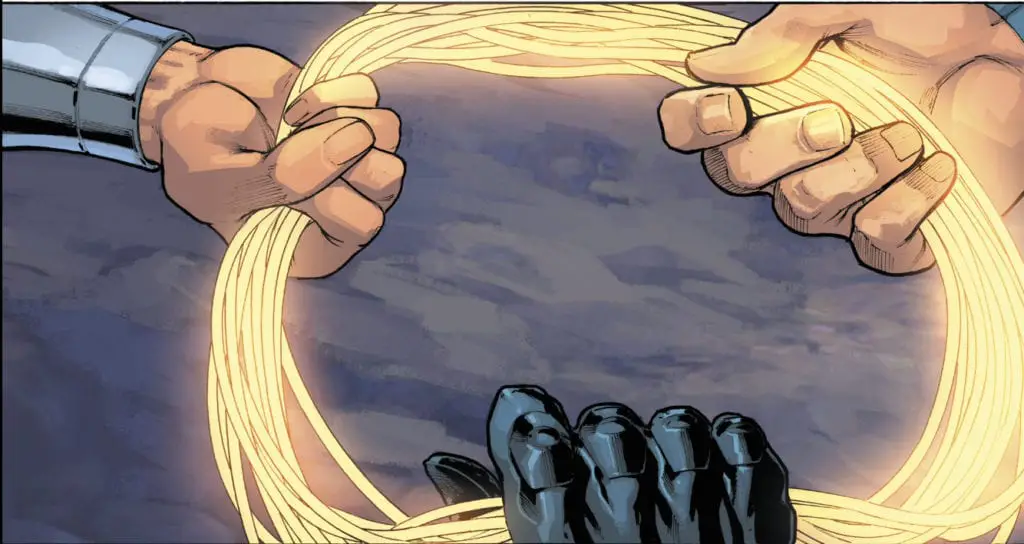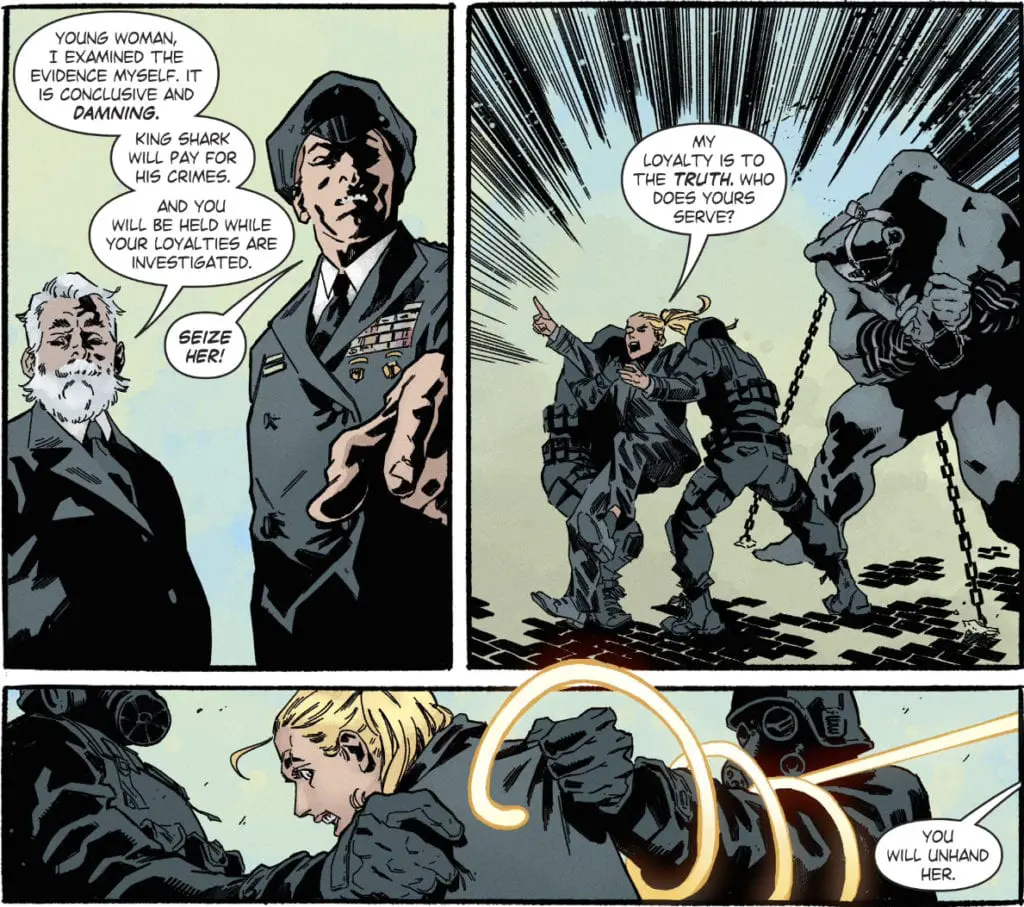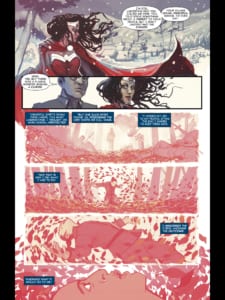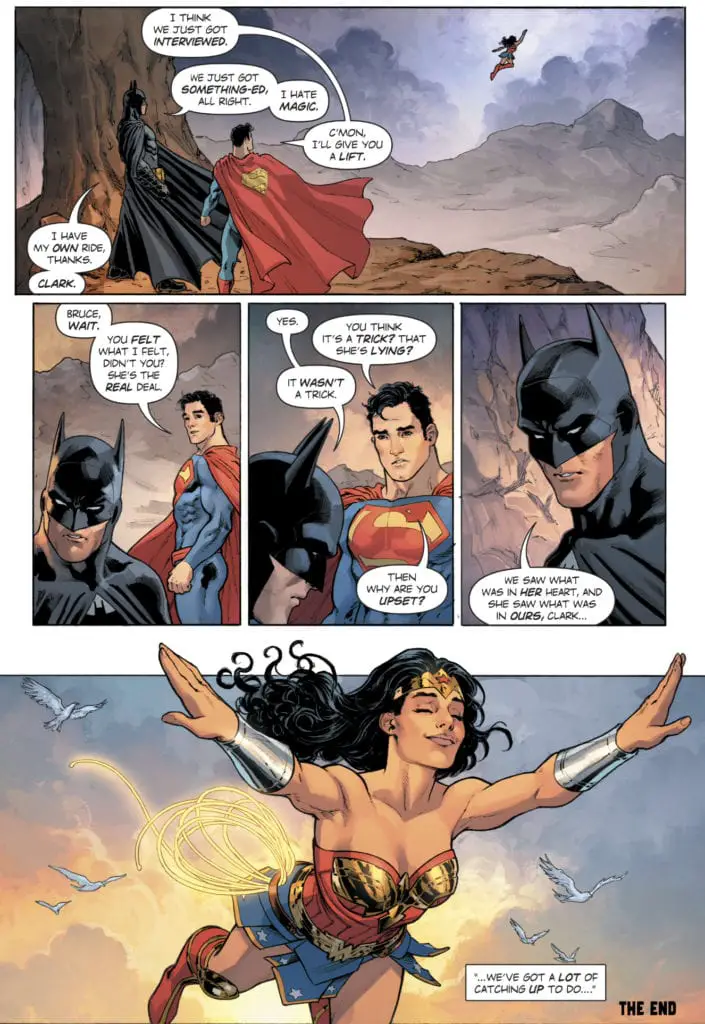This is a big week for Diana of Themyscira: We get the release of the Wonder Woman movie this weekend, and we also had “Wonder Woman Day” on Wednesday May 31. As part of Wonder Woman Day, not only did I leave my comic shop wearing a cardboard crown and a pair of bracers that I kept on for the rest of the evening, but I also had the Wonder Woman Annual #1 issue.
Written and drawn by four separate teams of writers and artists, the Annual is a collection of short stories that manage to show different aspects of who and what Wonder Woman is supposed to be. Some have a clear position within the ongoing storyline of the Wonder Woman series, and some are just isolated vignettes. Together, they manage to give us action and violence and super heroics and just enough touches of heartwarming emotion.
The first story is written by Greg Rucka, the author of the ongoing series whose tenure is sadly coming to a close with issue #25. Set within the early “Year One” arc — and including a few recreations of select panels in earlier issues — this story shows the first meeting between Wonder Woman, Superman, and Batman.

Superman and Batman both learn of her in their own unique ways, Clark Kent seeing her picture splashed across the Metropolis Times Square and Alfred pointing Batman to the same news on the Bat-computer. Independently they decide to go investigate, and inevitably they bump into each other as they observe Diana on the military base where she stayed after appearing in Man’s World. Batman GRUMPS at Superman, Superman CHARMS right back, and all told we get this delightful little scene of the two of them being bickering best friends. Personally, I love scenes like this, especially in this-day-and-age, because so many works try so hard to make them enemies. One reason I hate Batman v Superman: Dawn of Justice (One reason of many) was the meaningless antagonism that served no purpose other than to have two people who are supposed to be heroes beat the crap out of each other. It was pointless in and of itself in that one movie, and was another link in the ever-growing chain of pointless conflict.
Here, though, they know that they are on the same side, so there is nary a batarang thrown in anger.

Then Diana herself shows up, and again we get the scenes that I love: She has seen that they are spying on her so she sneaks up behind them, but she does not just attack. At this point in the timeline Diana is still very new to Man’s World, so she does not know who Batman and Superman are, and a lazy writer would have used this opportunity for more of that pointless conflict I complained about. It is a very cliched story when heroes first meet that I’m sure you’ve read a thousand times: She attacks them because she figured they are evil and they attack her because they figure she is evil, and at the end they all become friends while I sit here pulling out my hair because if they were truly “heroes” they should not have just decided to murder each other in the first place.
Instead, this goes in what should be the obvious direction: Diana pops up behind them and asks who they are and why they are spying on her.

After they stumble over the language barrier—something that the “Year One” arc had established back in the beginning of the series—Diana has them all grab onto her magic golden lasso and speak The Truth. They introduce themselves, establish that none of them mean the others any harm, and part on good terms. And…that’s it. That is the end of the story. They separate with all of them deciding that they do not need to stupidly murder each other in a nonsense conflict, and they they can be friends together in the future.
This little story does not contain a single fight panel, and not one twisted reveal of “OMG BATMAN IS ACTUALLY EVIL!” or “SUPERMAN IS TOO POWERFUL TO TRUST!”. Its entirety is just people talking and theorizing, and this is exactly what it needed to be. Though they come at it from different angles, both Superman and Batman are supposed to be smart and compassionate and inherently Good, and Wonder Woman’s entire series has been spent establishing the same facts about her. It would make no sense for the first meeting of these characters to involve them fighting each other without some bizarre story contrivance, and that would have gone against the entire tone of this series in particular and much of the DC Rebirth in general.
The scene of their meeting also includes many references to the established characters of these people. Diana does not refer to herself as “Wonder Woman”, since that is an appellation that has been slapped on her by Man’s World, and only recently at that. Similarly, Superman introduces himself with his human and Kryptonian names, but not his superhero identity. It has been part of the Superman canon for decades (Not counting a few…digressions) that Clark Kent is the “real” person beneath the costume that is Superman, and the lasso brings that out. In contrast, though, Batman does introduce himself only as Batman. To him, the masked identity is who he is, and even though Superman snickers at it, he also accepts it and does not try to ‘out’ him by telling Diana his birth name.
All told, this sequence sets the perfect base for what will eventually become a deep friendship and the committed team of all three of them.
The next story is a little bit more standard superhero fare (There is even some fighting), but I will say that it does not hold together quite as well as the opener. Set in Markovia, a longstanding fictional country within the DC Universe that is the origin of characters like Geo-Force and the original Terra, it opens with the public execution of King Shark for the murder (and eating) of a Markovian general. Just as the order is given, however, a young military officer named Captain Beckers — presumably his defense attorney but never really explained — leaps forward and explains that King Shark couldn’t have done the deed, and that his conviction is a fraud. When her loyalties are questioned by those running the execution, she offers the only retort possible for a Wonder Woman comic: her loyalty is to the truth. Naturally, the Avatar of Truth herself comes to the rescue.

Wonder Woman explains that she has been sent by the Justice League to investigate this execution, as it apparently violates an international treaty. One of the key points here is that she does not just say “I am here to free King Shark” and let that be an end to it. King Shark really is a supervillain, and it certainly is possible that he did the deed of which he is accused. What she says is that King Shark will be released pending investigation of his crimes. The ‘proper authorities’ (Presumably the Justice League) are going to look into what happened, and if King Shark really did eat the general he will be punished, but Wonder Woman is not going to let that punishment be the enraged howling of a mob when it has not yet been established that he is guilty.
 There is a fight, Wonder Woman tossing aside the soldiers staging the execution and Captain Beckers dramatically saving her from being shot from behind in one instance, before King Shark breaks free from his shackles. After the abuse and hurt he has suffered he begins a rampage of his own, only to be stopped in turn by Wonder Woman who explains that his retaliation upon the assembled peoples would be no more just than his own treatment. With the lasso to compel his honesty, King Shark explains that he was swimming alone in the sea when he was kidnapped by members of the Markovian military three days ago and framed for the murder. They viewed the General as being too peaceful, too willing to compromise with foreign nations, and too “weak”.
There is a fight, Wonder Woman tossing aside the soldiers staging the execution and Captain Beckers dramatically saving her from being shot from behind in one instance, before King Shark breaks free from his shackles. After the abuse and hurt he has suffered he begins a rampage of his own, only to be stopped in turn by Wonder Woman who explains that his retaliation upon the assembled peoples would be no more just than his own treatment. With the lasso to compel his honesty, King Shark explains that he was swimming alone in the sea when he was kidnapped by members of the Markovian military three days ago and framed for the murder. They viewed the General as being too peaceful, too willing to compromise with foreign nations, and too “weak”.
This is where this story has trouble finding itself. It never explains why they chose King Shark to frame for the murder of General Laurent. As a character he has no history with Markovia, and no political or ideological motivations that could reasonably point to him as an assassin. The caption boxes also explicitly state that he was captured off the coast of France, which means that the murderers specifically sought him out in foreign territory, it’s not as though he was within their own reach and they decided to seize on him as a target of opportunity.
I can’t help but just wonder why? Why does their assassination plot revolve around kidnapping a supervillain from another country and framing him for eating the general? Why not jus hire a regular assassin (Deadshot, for example, who even has a history with King Shark in the Secret Six series), or frame somebody who might have motivations for being involved in Markovian politics (The Teen Titans and the Outsiders both have long histories with Markovia)? These questions are never answered, and everybody reacts as though “Military officers frame a man/shark monster for eating their superior officer” is a normal way to stage a coup d’etat.
 Despite these story problems, this section does manage to bring it together for the close. Diana brings King Shark to the sea again and explains that, though he was innocent here, he has done horrible things in the past. His mistreatment at the hands of the Markovians does not absolve him of that. She will not, however, simply execute him or beat him up. What would that solve? Instead, she offers him a chance for atonement.
Despite these story problems, this section does manage to bring it together for the close. Diana brings King Shark to the sea again and explains that, though he was innocent here, he has done horrible things in the past. His mistreatment at the hands of the Markovians does not absolve him of that. She will not, however, simply execute him or beat him up. What would that solve? Instead, she offers him a chance for atonement.
Waiting for them at the sea is Aquaman, somebody whose nature can connect with King Shark in a way that normal humans can’t. His status as King of Atlantis also gives him a position to pass judgement on the crimes committed by a sea-creature like King Shark. He will take custody of King Shark, supervise him, and even attempt to rehabilitate him. King Shark has only ever been treated as a monster, and maybe with somebody treating him as a person, he can make a change to his ways.
Of course, maybe not, too, because even as he walks off he tells Diana that he is not making any promises that he will become a good a person, and Diana is not surprised. There is, however, the chance that maybe this connection will bear fruit. For Diana, that chance is enough to make the effort, and maybe the fact that it was enough for her will make it enough for him too.
 The third story of the annual diverges pretty heavily from either of the two before it. Instead of being a traditional superhero story, this is instead told like horror/fantasy as Diana apparently finds herself in Japan, drawn there by a request for help from Kikori. Kikori is either an old friend of hers or an old friend of Steve Trevor’s, and he has asked her to help protect his village from a terrible danger.
The third story of the annual diverges pretty heavily from either of the two before it. Instead of being a traditional superhero story, this is instead told like horror/fantasy as Diana apparently finds herself in Japan, drawn there by a request for help from Kikori. Kikori is either an old friend of hers or an old friend of Steve Trevor’s, and he has asked her to help protect his village from a terrible danger.
Years ago a curse fell upon his village, brought by evil spirits, and to protect his village he took the curse within himself. Now the curse is about to break free, and he has asked Wonder Woman here so that she can kill him to continue to protect his village. Naturally she refuses, but he begins to transform, attacks her, and ultimately turns towards the village itself. To protect the people there, whom Kikori had accepted the curse to protect in the first place, Diana ultimately kills him and saves the village.
I’m…not quite sure what to say about this story, because honestly I’m not quite sure how we’re supposed to take it. Kikori apparently means a lot to Diana, but to my knowledge he has never been seen before in any comic book or story, and we do not get any details as to what kind of history they have together. How deeply is he connected to her? Is he a former mentor? Former partner in crime fighting? Did he serve in the military with Steve Trevor? Who is he?
Additionally, though the idea of “Warrior with a curse needs another warrior to defeat them” is a relatively common story (I can think of two examples from Samurai Jack alone: “Jack and the Lava Monster” and “Jack and the Three Blind Archers”), this is usually because something about the curse or their philosophy prevents them from stopping themselves. I never — ever — wanted to write this sentence, but as it is presented I find myself wondering why doesn’t Kikori just kill himself? Unlike the Lava Monster, who was a Viking and needed a death in combat in order to reach Valhalla, Kikori expresses no desire to die in combat, he just wants to die to protect his village. Unlike the Three Blind Archers, who have been taken over by the Well and lost their free will, Kikori seems to be completely free to act until the curse comes out. With none of these limits on his actions, why does he call Wonder Woman out here to do it for him? Why does he place this burden on her shoulders?
If he truly cannot stop himself, then why not just leave? I mean that literally: Board a plane and fly across the world. He stated that the curse was in the land of his village, so if he (And the curse) are somewhere else then everybody should be safe.
Maybe the story is just a victim of the this annual’s format, a tiny vignette that does not have time to flesh out these details, but instead of being struck by the emotional power of a man sacrificing himself to protect his village, I just find myself wondering why any of it was necessary.
The fourth-and-final story of the issue decides to leave behind the darkness of the last two bits, and instead jumps over to a bright, fun adventure.
 This adventure opens as a kaiju—an out-and-out kaiju—rises from the sea and begins its attack. This is straight out of Godzilla or Pacific Rim, only instead of a giant robot, the defense (Not counting the military) is Diana. She arrives and begins to wallop on on the giant monster, which in turn begins to wallop right back. She is almost having fun in the challenge of the fight when the lasso gets entangled around the monster and its powers allow her to understand it: It is not here to attack. Not deliberately, anyway.
This adventure opens as a kaiju—an out-and-out kaiju—rises from the sea and begins its attack. This is straight out of Godzilla or Pacific Rim, only instead of a giant robot, the defense (Not counting the military) is Diana. She arrives and begins to wallop on on the giant monster, which in turn begins to wallop right back. She is almost having fun in the challenge of the fight when the lasso gets entangled around the monster and its powers allow her to understand it: It is not here to attack. Not deliberately, anyway.
It was alone on an island, apparently the last of its kind when it hatched from its egg next to its mother’s corpse, and it left its island seeking companionship and friendship and people. It is not its fault that it is a giant monster, and it has no desire to smash or destroy if people would just stop trying to destroy it first. But it never gets a chance to forge these connections, as everywhere it goes people flee in terror.
After forging this connection Diana of course decides to help the creature — what else could she do — but the military will not listen to her and presses its own attack. Diana knows they cannot fight off the armed forces, especially not without causing all the destruction that they want to avoid in the first place, so she finds the solution that solves all of the problems: She brings the kaiju to Dinosaur Island, the Ancient Home of Monsters. Not only does this bring him away from the military and all the scared people trying to blow it up, but it also fulfills its one dream: Friendship, with all of the other monsters there.
That, and playing a game of fetch with Diana.
This story ends the annual with a fun, enjoyable little romp that does not need to answer too many questions because it does not raise too many questions. Since it does not try and connect the monster to anything else, it is just one of the whacky things that happens in the DCU, and we are able to not ask the questions that bogged down the middle two stories. It is just sweet and heartwarming and, dare I say it, cute. It makes me want a kaiju of my own.
All told, this Annual managed to touch on several different forms of story, and presented several different aspects of Diana. We saw her in action, and we saw her in conversation, and we saw her at both the depths of killing a man and the heights of playing games with a new friend. Even with the questions I have for the middle stories it’s not a loss. All told it sets the stage for the Wonder Woman movie, and leaves us with the indelible presentation of who Diana is:
Diana helps. Diana seeks for the truth. Diana fights when she must, and cares when she can. She is both warrior and leader and healer, and so much more.




